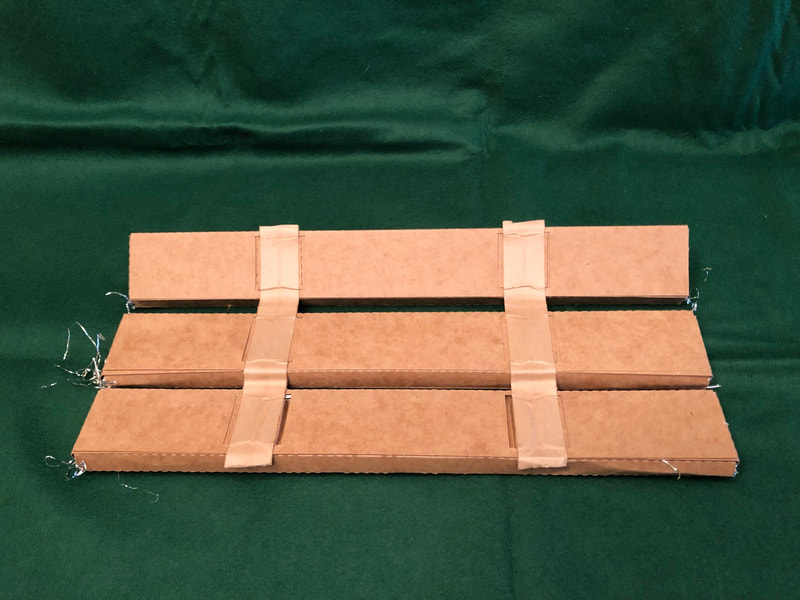|
Our featured artifact is a bundle of radar jamming foil strips that were commonly referred to as ‘chaff’ during WWII. It is a somewhat common misconception that the British were the first to develop RADAR during WWII. This is probably due to the widespread attention given to the tall radio transmission towers that were commonplace along the British coast of the English Channel that were successfully used in detecting incoming German bombers during the Battle of Britain in the summer of 1940. However, RADAR’s (an acronym for RAdio Detection And Ranging) origins can be traced as far back as the late 1800’s, when in 1886 a German Physicist named Hertz showed that radio waves could be reflected from solid objects. As is often the case, word spread in the scientific community. Independent researchers in Britain, France, Italy, Germany, Japan, the Netherlands, the Soviet Union and the United States realized the value of this technology and worked independently and in great secrecy on developing the system which would become modern RADAR. Essentially, RADAR uses radio waves to determine distance (range), angle and velocity of the object in relation to the radar site. The acronym (RADAR) was first coined by the U.S. Navy in 1940 and the term ‘radar’ became commonplace thereafter. Along with the British and Americans, the Germans also had their own functioning radar system at the outbreak of WWII. They had not only developed long range radars to detect incoming bomber streams, but had also developed smaller microwave radar systems that could be used to direct Flak gun batteries as well as searchlights towards incoming aircraft to great effect. As with any technology during wartime, attention was quickly turned towards an effort to counter the radar systems. Like the development of radar, the idea of a countermeasure to radar was simultaneously being developed in the UK, Germany, the United States and Japan. In 1942, it was a Welsh researcher by the name of Joan Curran that first came up with the idea of dumping packs of size-specific aluminum strips from aircraft to generate a cloud of false echoes to the originating radar. It was discovered that the system was most effective when the strips were cut to a length and width that was one half of the target radar’s wavelength. When the chaff was hit by the radar beam, it would resonate and re-radiate the signal back, virtually cluttering and overwhelming the radar signal. The opposing radar operator would find it almost impossible to distinguish aircraft from the echo caused by the chaff and therefore mask the location and speed of the aircraft. Unknowingly, the Germans and Japan had also developed similar countermeasures. The British called theirs ‘window’, Germany had ‘duppel’ and the Japanese had ‘giman-shi’ (deceiving paper) as well as the American ‘chaff’. Both the Axis and the Allies were hesitant to use the countermeasure in fear that the technology would soon be discovered by the other side and used against them. RAF Bomber Command was finally given permission by Air Chief ‘Bomber’ Harris for use in Operation Gommorah, the night bombing raid on Hamburg in July of 1943. The results were overwhelmingly successful. With the radar systems swamped by false echoes, searchlights wandered aimlessly around the night sky and flak guns fired randomly and failed to locate the bomber stream. Chaff was used regularly thereafter by the Allies. Initially chaff was simply heaved out open windows on the bombers until modifications were made using a designed chute in which chaff was fed through the aircraft into the slip stream at timed intervals. Later, automatic chaff dispensing systems were developed. Chaff was used successfully throughout the remainder of the war until the Germans developed new technologies that helped counter their effect. Our example of bundled chaff strips are roughly 16” long by 1mm wide and would have been used against a specific type of radar. Other examples of wider or longer aluminum strips would have been used against radars of a different (i.e.- long range vs. short range radar) wavelength. The bundles shown were designed to break apart in the slipstream and release its contents into the air. Chaff was a cheap and simple, but effective development which undoubtedly saved countless lives of airmen during the second world war.
1 Comment
|
AuthorWelcome to the CAF MN Wing Blog. You will find information on projects we are working on, upcoming events, and more. Archives
April 2024
Categories
All
|



 RSS Feed
RSS Feed